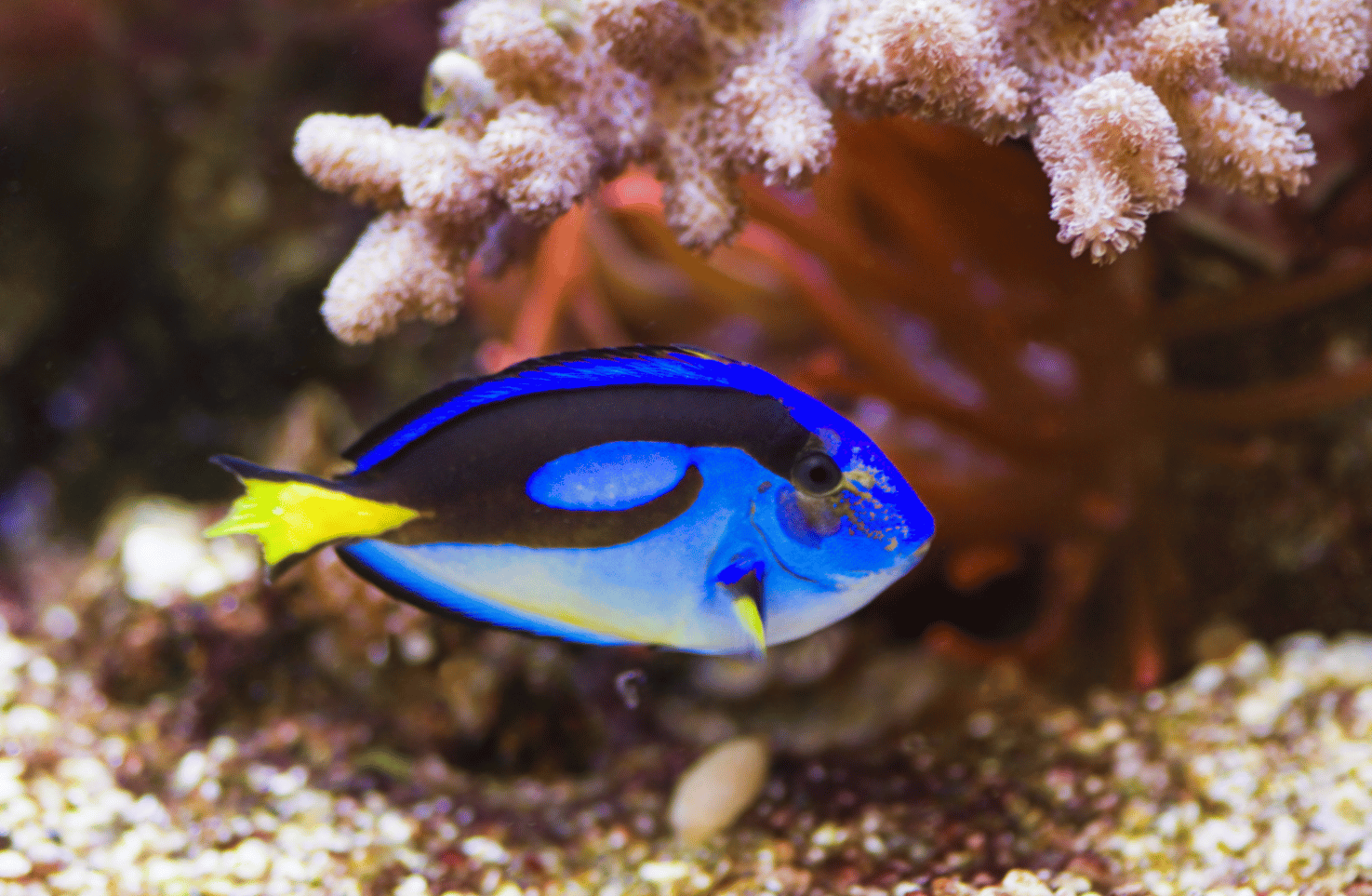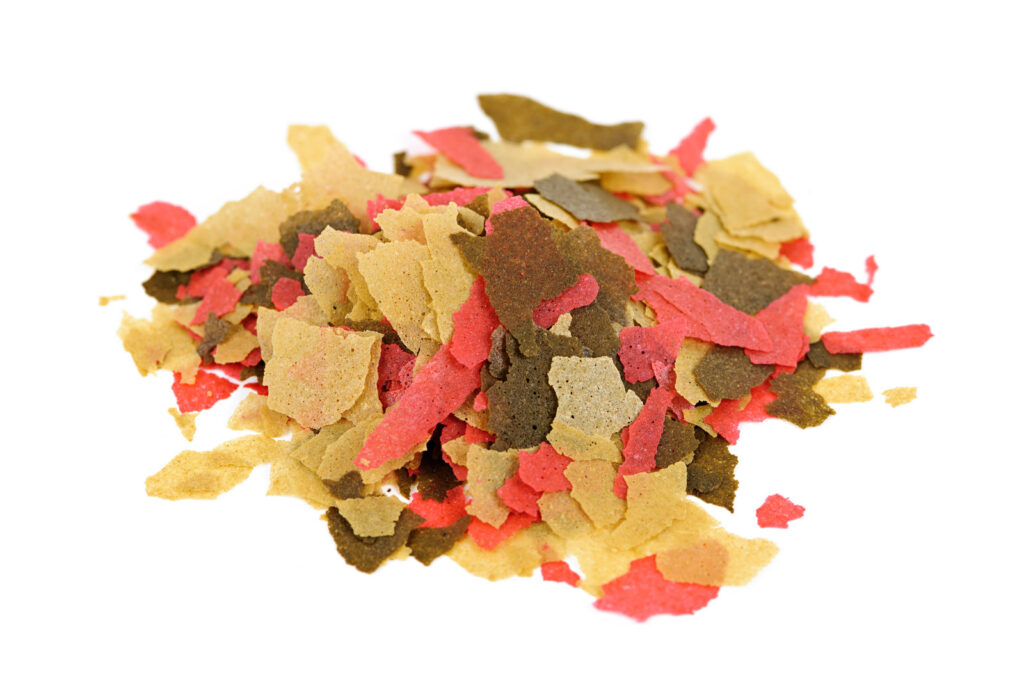Your cart is currently empty!

Feeding Blue Hippo Tang: Best Foods and Nutritional Tips
The Blue Hippo Tang (Paracanthurus hepatus), also known as the Regal Tang or Palette Surgeonfish, is popular among saltwater aquarium enthusiasts due to its striking blue and yellow coloration. Ensuring your Blue Hippo Tang thrives in captivity requires more than just a beautiful tank; it hinges on providing a well-balanced, nutritious diet.
Proper feeding enhances their vibrant colors and promotes overall health and longevity. This article covers the best foods and essential nutritional tips to keep your Blue Hippo Tang happy and healthy, transforming your tank into a thriving underwater paradise.
Best Foods for Blue Hippo Tang in Captivity
Blue Hippo Tangs inhabit coral reefs across the Indo-Pacific region in their natural habitat. Here, they primarily graze on various algae types, providing them with essential nutrients for their health and vitality. Understanding their natural feeding habits is crucial to replicating a similar diet in captivity.
Nori (Seaweed Sheets)
- Nutritional Benefits: Nori is a type of dried seaweed that is highly nutritious. It contains essential vitamins and minerals such as Vitamin C, iodine, and fiber. It’s an excellent source of roughage and helps mimic the natural grazing habits of Blue Hippo Tangs.
- Feeding Method: Attach nori sheets to a seaweed clip inside the tank or place them under a rock to allow the tang to graze naturally. This method encourages their natural feeding behavior.
Spirulina
- Nutritional Benefits: Spirulina is a blue-green algae known for its high protein content, essential amino acids, vitamins (B complex, E), and minerals. It supports vibrant coloration and overall health.
- Feeding Method: Spirulina can be easily added to their diet in flake or pellet form. It should be provided in small, frequent amounts to simulate their natural grazing habits.
Romaine Lettuce
- Nutritional Benefits: While not as nutrient-dense as marine algae, romaine lettuce provides roughage and essential vitamins. It is a good occasional treat.
- Feeding Method: Blanch the lettuce to make it easier for the tang to digest and place it in the tank using a clip or weighted holder.
Spinach and Kale
- Nutritional Benefits: These leafy greens are rich in vitamins A, C, and K, as well as calcium and iron, contributing to a balanced diet.
- Feeding Method: Blanch these greens before adding them to the tank, like romaine lettuce. Offer them a couple of times weekly to provide variety.
Mysis Shrimp
- Nutritional Benefits: Mysis shrimp are small crustaceans that are rich in protein and other essential nutrients. They closely mimic the small invertebrates that Blue Hippo Tangs might consume in the wild.
- Feeding Method: Available live, frozen, or freeze-dried, mysis shrimp should be thawed if frozen before feeding. They can be offered as an occasional supplement to the tang’s diet.
Brine Shrimp
- Nutritional Benefits: While less nutritious than mysis shrimp, brine shrimp provide protein and are readily accepted by Blue Hippo Tangs.
- Feeding Method: Feed live or frozen brine shrimp a few times a week, ensuring they are thawed if frozen.
Herbivore Flakes and Pellets
- Nutritional Benefits: These commercial foods are specifically formulated for herbivorous marine fish and contain a mix of algae and other essential nutrients, ensuring a consistent dietary intake.
- Feeding Method: Sprinkle flakes or pellets lightly across the water surface to encourage natural foraging behaviors.
Frozen Food Mixes
- Nutritional Benefits: These mixes often include various types of algae, shrimp, and other marine foods, providing a balanced diet.
- Feeding Method: Thaw frozen food before adding it to the tank. Feed small amounts to avoid overfeeding and maintain water quality.
Nutritional Requirements
- Proteins: Essential for growth and repair. Blue Hippo Tangs require a balanced intake of proteins, which can be provided through meaty foods like shrimp.
- Vitamins and Minerals: Vital for immune function and overall health. Ensure their diet includes a variety of sources to provide these nutrients.
- Signs of Deficiencies: Color fading, lethargy, and fin erosion are common indicators. Address these issues by adjusting their diet and ensuring they receive various nutrients.
Feeding Tips and Techniques
Properly feeding your Blue Hippo Tang ensures their health and vibrancy and contributes to a balanced and thriving aquarium ecosystem.
Feeding Schedule
Feeding a Blue Hippo Tang (Paracanthurus hepatus) effectively involves carefully balancing frequency, portion control, and simulation of natural behaviors. The feeding schedule should consist of 2-3 small meals daily, each lasting just a few minutes.
This approach not only helps in preventing overfeeding but also mirrors the natural grazing habits of Blue Hippo Tangs, which spend their days nibbling on algae and other food sources in their natural reef environment.
Maintaining a regular feeding schedule is crucial as it ensures that the fish receive consistent nutrition without contributing to excess waste in the aquarium.
Avoiding Overfeeding
Overfeeding is a common mistake that can lead to significant health and water quality issues. Excess food that is not consumed decomposes, leading to poor water quality which can result in various health problems for the fish, such as obesity and fatty liver disease.
Observing your Blue Hippo Tang’s feeding habits and adjusting the portion sizes accordingly is vital. Using protein skimmers and performing regular water changes can help manage waste and maintain a clean environment.
Efficient filtration systems are also essential for removing uneaten food and other waste products and preventing the buildup of harmful substances in the tank.

Encouraging Natural Feeding Behavior
Encouraging natural feeding behaviors is another key aspect of properly feeding Blue Hippo Tangs. Using clips for algae sheets can simulate the natural grazing behavior, reducing stress and promoting healthier feeding patterns. This method allows the fish to feed as they would in the wild, slowly grazing on algae throughout the day.
Additionally, creating a stimulating feeding environment by incorporating live rock and hiding spots in the tank can mimic their natural habitat.
These elements provide places for algae to grow, offering a natural food source and encouraging the fish to engage in natural foraging behaviors. Thus, the feeding process is more engaging and beneficial for the fish’s well-being.
Common Feeding Mistakes to Avoid
- Impact on Water Quality: Excess food decomposes and deteriorates water quality, leading to health problems for your fish. Regular use of protein skimmers and frequent water changes are essential to maintain a clean environment.
- Managing Waste: Use high-quality filtration systems and perform regular maintenance to remove waste and prevent the build-up of harmful substances.
- Ensuring Adequate Nutrition: Monitor their food intake to ensure they are getting enough to eat. Adjust the diet to include a variety of foods to meet all nutritional needs.
- Avoid Terrestrial Vegetables: Foods like lettuce lack the necessary nutrients in marine-based algae and can lead to deficiencies. Stick to marine algae and specifically formulated fish foods.
Monitoring Your Blue Hippo Tang’s Health
- Indicators of Health: Healthy Blue Hippo Tangs are active, brightly colored, and exhibit natural grazing behavior. Regularly observe your fish for any changes in behavior or appearance.
- Regular Health Check-ups: Conduct regular water tests to ensure optimal water quality. Look for signs of common diseases such as Marine Ich and Velvet, and take preventive measures to address them promptly.
Feeding Your Blue Hippo Tang? Dive Deeper with Boca Aquarium’s Marine Marvels!
Have you ever wondered what it takes to create a thriving underwater paradise for your Blue Hippo Tang? While feeding your Blue Hippo Tang the best foods and following essential nutritional tips, why not take a moment to immerse yourself in the enchanting world of marine life at Boca Aquarium?
Witness the majesty of sharks, the vibrant beauty of reef ecosystems, and the delicate charm of seahorses. Each exhibit showcases the splendor of marine life and promotes conservation and a deeper understanding of these vital ecosystems.
Explore, learn, and be inspired by the ocean’s wonders at Boca Aquarium!
